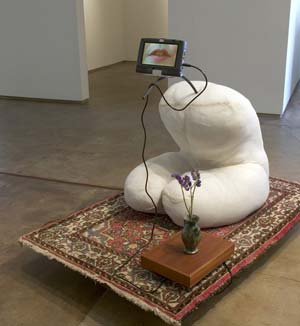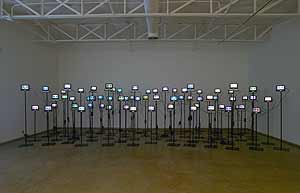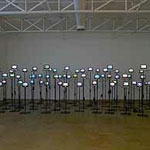A bulbous, overstuffed body meets blinking eyes on flat screens in the work of Witness, where the artist Frances Bagley achieves a tour de force combining fuzzy, touchable matter and disembodied homo electronicus. Bagley is without a doubt one of the smartest, most talented artists of the metroplex and beyond. To visit the studio belonging to Bagley and artist-partner-in-crime Tom Orr is to step into a cavernous space that stretches the mind.
Bagley designs odd-body scenes that give new vibrancy to the idea of the amorphous. Here one finds fur that falls from wall to floor to a tabletop set with a dainty flower in a vase. There one finds life-size, shiny gold deer in whitish, rolling-hill terrains, where the flickering eyes of their pet pug, Peggy, another found object, stare back undaunted from a tiny flat monitor. Bagley ratchets up the stakes of peculiarity set by godfathers of the odd Hans Bellmer and Marcel Duchamp. Her work gives the ball-and-socket frisson of Bellmer’s Poupée series and the bald mons pubus of Duchamp’s Etant donnés a run for their money. Here, here to Bagley!

Frances Bagley...Who Are You?...2005-06...Mixed media and video monitor w DVD... 45 x 60 x 38 inches...
Unfortunately, the show at Marty Walker Gallery seems but a minor preview of Bagley’s talents. When seen in light of Bagley’s larger oeuvre, the three pieces in the front-room gallery read as flat and safe. Judgment is a phalanx of small dashboard DVD monitors, each of which runs a loop of paired, blinking and tearing eyes. The monitors sit atop minimalist black steel stands arranged in chamber-orchestra formation, forcing the viewer to shift perspective between maestro-conductor and victim of the collective gaze. Who Are You? is a bloated, headless, handless, footless female body out of which emerges a metal peduncle, atop of which sits a small platform holding a screen that shows a woman’s mouth repeating, “Who are you?” The round body is tightly cased in white fabric and buoyantly placed on top of a small Persian rug next to a tiny wooden tabletop with a bud vase of flowers. The Question shows a loop of five horse eyes, each peering through a small hole in a large swatch of dark brown faux fur and blinking at its own rhythm. The fur hangs on the wall, mirroring back at us our scrutiny of form.
In describing the show as “flat,” I mean to call attention to the manner in which this show tiptoes along the fault lines of what could develop into an all-out ground shaking and swallowing up of the city’s principles of etiquette. This small collection lies literally supine, in deference to some version of the “Dallas public.” It panders to an almost-true-to-life caricature of Dallas and ultimately underestimates what our miniature Republic of Politesse can handle. The best way to cure a city of its seeming inability to stomach the bombast of daring good art is to feed it more. In keeping with Jacques Derrida’s translation of the Greek word pharmakon, poison is remedy and vice versa. What Dallas desperately needs is more, not less, over-the-top Baroque bravado form. In stomaching what it claims not to be able to handle, it will become stronger, wiser and, most important of all, more open to difference. Come on, Dallas: The world has learned to live with your assassination of one her greatest. Now it’s your turn to pony up to tolerance and learning-to-live-with. Ingest the pharmakon of Bagley’s creature comfort-discomfort, let go, and see what happens.
Bagley’s work plays on the treachery of precisely those fears of letting go in a world where you’re potentially always being watched. The blinking eyes and querying mouth of the miniature displays seem to tell us, even if you’re brave enough to let caution fly to the wind, you”ll always be the subject of someone’s watchful gaze. Michel Foucault long ago warned of the powers of decentralized technology. Close-circuit monitoring transformed Bentham’s panopticon from architecture to screen, and the rest is history, from the Rodney King tape to Funniest Home Videos to YouTube. You”ll always be surveyed and judged, even if you’re watching yourself. The overarching thesis of this work is the power of vision: its ability to construct norms and identities while maintaining the control of the State, whether the government or corporations into consumer engineering.
Bagley’s work is very close, perhaps too close for some, to the work of Tony Oursler. Bagley’s Who Are You? is similar to Oursler’s don’t Look at Me (1994). Both artists use doll bodies — one small and delicately dressed, the other Venus-like — and video to stage perverse comedies of existential worry. But Bagley’s work is enough her own to combat facile criticisms that she’s over-borrowed from Oursler. The faces of Oursler’s dolls are projected, while the eyes and mouth of Bagley’s subjects are all on screens. More importantly, the lode of technology from which Bagley and Oursler mine their techniques and processes is deep and wide enough for a fair bit of digging. The medium of video-in-environment is bold and fathomless, and there’s enough room for Bagley to do her thing, even while rubbing shoulders with Oursler and with another great, Pipilotti Rist.
Images courtesy Marty Walker Gallery.
Charissa N. Terranova is an Associate Proffessor at SMU and a Contributing Editor to Glasstire.





